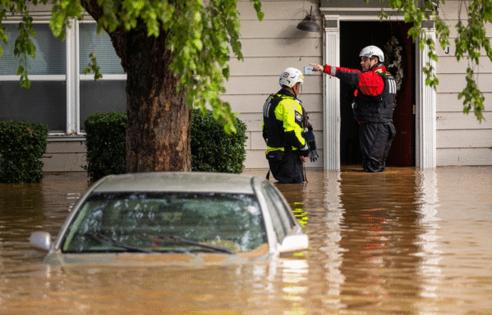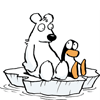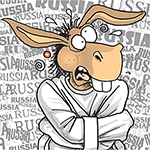As weather gets more extreme, so do conspiracy theories. Can cloud-seeding cause floods?
Published in News & Features
RALEIGH, N.C. — Even with his years of experience and the technology at his disposal, meteorologist Don “Big Weather” Schwenneker says it can be challenging to accurately forecast severe weather. But when a storm or hurricane hits North Carolina, bringing major flooding or damaging winds, a certain number of his ABC11 viewers will react in a way that’s become entirely predictable.
“This is unnatural,” they’ll say. Or, “No way this isn’t man-made.”
They aren’t talking about the long-term effects of man’s use of fossil fuels or other activities scientists say have warmed the Earth and changed its weather patterns over the past two centuries.
“They’re conspiracy theories,” Schwenneker says, pointing to notions typically shared through social media by those who believe malevolent forces are working inside — or along with — government to weaponize the weather, creating or steering dangerous systems for nefarious purposes.
Theories circulating now hold that those agents have used cloud-seeding, chem-trails, high-resolution weather radar or radio frequency emissions to cause the July 4 floods blamed for at least 135 deaths in the Texas Hill Country; the above-average rainfall parts of North Carolina have seen in July, including the downpours from Tropical Storm Chantal on July 6 that caused severe flooding and at least six deaths; and flooding and landslides that killed at least 108 people in the N.C. mountains following torrential rains from the remnants of Hurricane Helene last September.
Some experts say the claims, which travel fast and can become entrenched, are far from harmless; they undermine faith in government and have inspired one group to try to destroy weather radar systems.
Can cloud-seeding cause floods?
Like many conspiracy theories, scientists say those around the weather may start with a real event or technology whose purpose or capability then gets embellished or misconstrued.
Experiments with cloud-seeding began in the 1940s with researchers from General Electric trying to identify the process through which ice forms on airplane wings, according to the Desert Research Institute. The process uses airplanes, drones or ground-based systems to introduce small particles of silver iodide or other material into existing clouds to create droplets heavy enough to fall as rain or snow.
After nearly 80 years of sporadic work, those still working in the field say cloud-seeding works only under a strict set of conditions and can increase precipitation over only a very small geographic area and by just a few percentage points over what would normally fall. That could be enough to help in cases of severe local drought, scientists say — or to clear away the clouds over the opening ceremonies of the 2008 Summer Olympics in Beijing — but not enough to turn a passing storm into a deluge like Chantal, which dropped more than 7 inches of rain in Orange County.
The fact that a cloud-seeding operation was undertaken in Texas days before the Hill Country flooding sparked widespread claims about a connection between the two, but meteorologists and researchers who have done similar work say it’s not possible. The effects of the catalysts last hours, not days, they say, and the area where they would be effective is much too small.
Meteorologists at the the National Oceanic and Atmospheric Administration say the extreme rain and flooding were the result of the convergence of a tropical system that had made landfall days earlier and a second system stalled over the Gulf.
‘Numbers don’t lie’
Schwenneker, a meteorologist for more than 30 years, said it sometimes seems he spends half his time trying to combat conspiracy theories. He sticks to his forecasts and graphics during newscasts, but answers questions about supposed plots that come to him online. He occasionally refutes obvious falsehoods, he said, such as videos shared recently on X that claimed to show flooding in Greensboro but that weren’t even from North Carolina.
NOAA tries to debunk the claims as well.
And yet, many states have passed legislation banning manipulation of the weather.
U.S. Rep. Marjorie Taylor Greene, a Georgia Republican, proposed legislation last week that would make “weather modification” a felony. In North Carolina, House Bill 362 introduced in March would ban intentional weather manipulation by cloud-seeding or the use of electromagnetic radio frequencies.
When people tell him cloud-seeding causes catastrophic flooding or that some human mechanism can create or steer hurricanes, Shwenneker said, “I try to address these things with the numbers, because the numbers don’t lie.”
It all comes down to power, he said, and not the kind that might be used to direct a disaster against political rivals or to create a national distraction.
“For instance, I don’t think people realize how much power is in a storm or a hurricane,” he said. “It’s enough to power New York City for, I don’t know, a couple of weeks or something. It takes about 9 power plants to power New York City for a day. As humans, we cannot generate enough power to go against the power Mother Nature can generate.”
Similarly, Schwenneker said, “Cloud-seeding a gigantic area would be like me jumping in the ocean and the ocean level going up. There is just so much moisture up there, we have never had the power to generate large enough amounts of precipitation to have any significant effect on it.”
If they’re false, why do conspiracy theories persist?
“Humans love a good story,” said John Llewellyn, an associate professor at Wake Forest University’s Department of Communication. An expert on urban legends, he was asked to testify in a 1997 Texas lawsuit in which Procter & Gamble sued Amway distributors for claiming the P&G logo was a satanic symbol.
It was not.
But that rumor took on a life of its own, as so many others have, in part because it was so outlandish.
On the internet, where a constant firehouse of ideas compete for attention, “The more bizarre the claim, the more attractive it is, in the sense of being ‘news,’” Llewellyn said. “‘Hey, I didn’t know so-and-so was the spawn of Satan.’ And whether that is true or real or not gets lost in the cheap thrill of the counter-normal claim.”
Conspiracy theories are especially alluring, Llewellyn said, if they explain something the listener is curious about and doesn’t understand. Weather is complicated; even with orbiting satellites, radar, computer modeling and human expertise, the National Weather Service often admits it has low confidence in its forecasts about where summer thunderstorms will pop up in central and Eastern North Carolina and how strong they will be.
“We’re dealing with the modern social-media version of searching for an answer that is consistent with my world view and my cast of heroes and villains,” Llewellyn said.
What harm do conspiracy theories do?
Democracy depends in part on balancing individual rights with the greater good, and Llewellyn said conspiracy theories undermine people’s faith that their government is working for the common good.
“It’s the ways in which disbelief and distrust have been fomented and fed to people that should be deeply concerning,” he said. “It’s not that the government doesn’t make mistakes. It does. But the notion of a malicious government — that’s a very serious matter and about as un-little-d-democratic as you can get.
“I mean, if we don’t at some level have the willingness and capacity to trust one another, that makes going forward a very dicey proposition.”
In May, the Washington Post reported that NOAA had warned its employees that an anti-government group was making threats against weather equipment its followers believed was being used as a weapon by the military. The group, Veterans on Patrol, also took credit earlier this month for vandalizing weather radar equipment at Oklahoma television station KWTV, the Arizona Republic reported.
There is some good that can come from believing that a force — human or otherwise — is harnessing the raw power to move oceans and beaches, to reroute rivers and dissolve mountains, Schwenneker said.
“If they’re really worried about weather manipulation, hopefully they are taking the precautions they should take: making emergency kits, figuring out evacuation routes and how they will access to power. These are things they should be doing anyway.
“Whatever’s causing it, it’s coming, and you still need to be prepared.”
_____
©2025 Raleigh News & Observer. Visit newsobserver.com. Distributed by Tribune Content Agency, LLC.







Comments